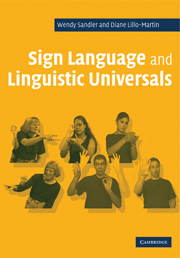Book contents
- Frontmatter
- Contents
- Preface
- Notation conventions
- UNIT I INTRODUCTION
- UNIT II MORPHOLOGY
- UNIT III PHONOLOGY
- 8 Meaningless linguistic elements and how they pattern
- 9 Sequentiality and simultaneity in sign language phonology
- 10 Hand configuration
- 11 Location: feature content and segmental status
- 12 The non-dominant hand in the sign language lexicon
- 13 Movement
- 14 Is there a syllable in sign language?
- 15 Prosody
- 16 Phonology: theoretical implications
- UNIT IV SYNTAX
- UNIT V MODALITY
- References
- Index
11 - Location: feature content and segmental status
Published online by Cambridge University Press: 05 June 2012
- Frontmatter
- Contents
- Preface
- Notation conventions
- UNIT I INTRODUCTION
- UNIT II MORPHOLOGY
- UNIT III PHONOLOGY
- 8 Meaningless linguistic elements and how they pattern
- 9 Sequentiality and simultaneity in sign language phonology
- 10 Hand configuration
- 11 Location: feature content and segmental status
- 12 The non-dominant hand in the sign language lexicon
- 13 Movement
- 14 Is there a syllable in sign language?
- 15 Prosody
- 16 Phonology: theoretical implications
- UNIT IV SYNTAX
- UNIT V MODALITY
- References
- Index
Summary
The designation of location as a major phonological category in sign language is unquestioned. Clear evidence is presented in Chapter 8, where the ASL minimal pair ugly, summer, distinguished only by some feature of location, is illustrated in Figure 8.2b. Like hand configuration, the location category is made up of subcategories with different characteristics. In particular, the major body area (such as the head) remains constant within a morpheme, while different subareas (such as the forehead or the chin) may have two different specifications in that domain (Sandler 1989). This categorization, too, is widely accepted. There is, however, one area of controversy with respect to locations that may be stated in terms of the following two views: (1) locations are a sequential segment type (as consonants are in spoken language); or (2) locations are a category on a par with hand configuration in a single feature hierarchy (like the place features of a segment in a Feature Geometry model). In this chapter, we will demonstrate the category-internal organization about which there is a consensus. We adopt the Hand Tier framework to represent it, making certain changes from the original model. The more controversial issue and what is at stake in it are laid out in the conclusion to the chapter. As this issue is related to the notion of syllables in sign language, it will be taken up again in Chapter 14.
- Type
- Chapter
- Information
- Sign Language and Linguistic Universals , pp. 174 - 181Publisher: Cambridge University PressPrint publication year: 2006



